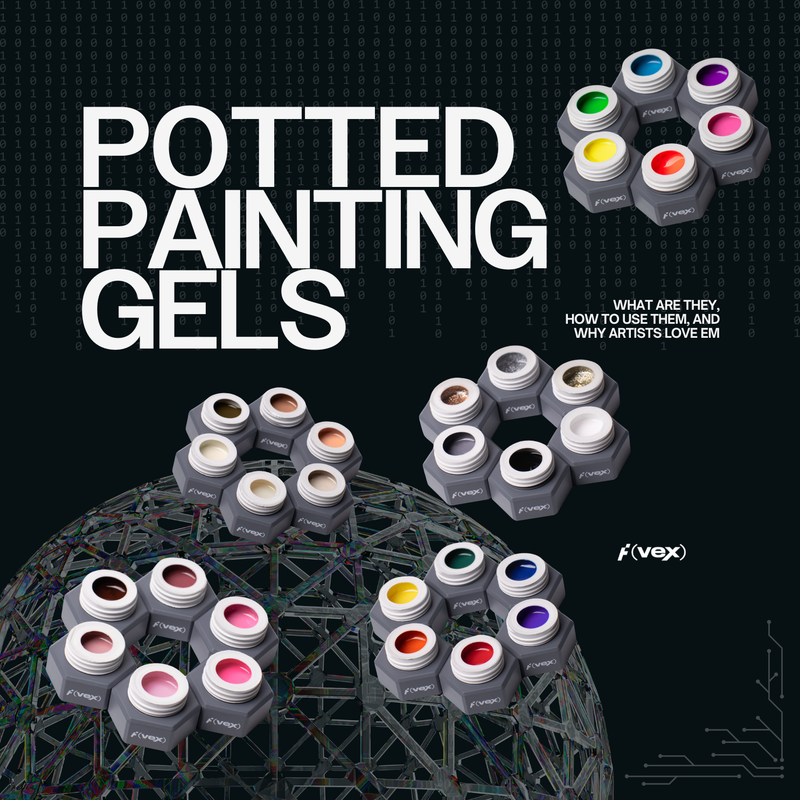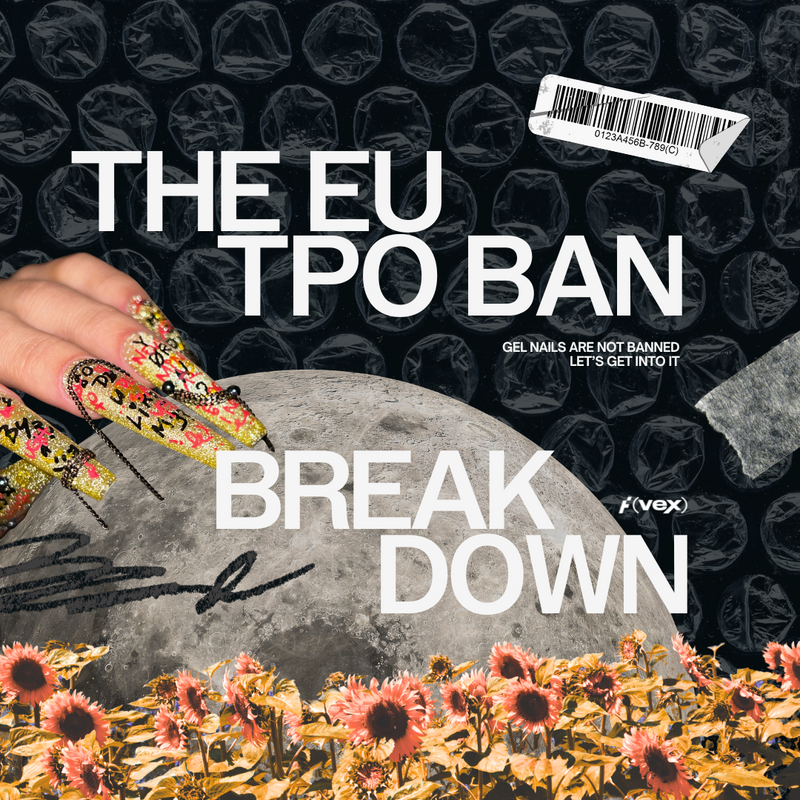Let’s be super clear right off the bat: we’re not talking about your gel peeling at the tips or builder lifting at the sidewalls. That’s a product issue. This? It’s deeper.
We’re talking about nail plate separation, when the actual nail separates from the nail bed underneath. The technical name for it is onycholysis, and it’s more common than you’d think.
Whether you’ve seen it on yourself or you’re a nail tech noticing it on a client, it can be a little alarming. It doesn’t always hurt. It doesn’t always look dramatic. But it always needs attention.
Because when that seal between nail plate and nail bed starts to break, you’re dealing with more than just a cosmetic concern.
Let’s walk through what’s really happening with nail plate lifting, what causes it, how to prevent it, and what to do when it shows up uninvited.
First Things First... What Is Nail Separation (aka Onycholysis)?
Nail lifting happens when the nail plate separates from the nail bed, usually starting at the free edge and working its way back.
It can look like a white or opaque gap between the nail and the skin underneath. Sometimes it’s mild. Sometimes it’s major. And sometimes it’s not even painful… but that doesn’t mean it’s not a big deal.
The medical term? Onycholysis. Sure, it sounds a little intense, but it simply refers to that separation process. It’s not always caused by disease, but it can be triggered or worsened by product issues, habits, trauma, or underlying conditions.
This post is made for techs and nail lovers, not for diagnosing medical conditions. But we’re here to help you recognize the signs and know what to do when it pops up.
What Causes Nail Bed Separation?
Let’s break this into buckets. Because this isn’t a one-size-fits-all situation.
Mechanical Trauma
Sometimes the damage is physical yet unintentional.
-
Over-filing the natural nail before application weakens the nail plate and makes separation more likely.
-
Improper e-filing, especially when filing close to the cuticle, can cause trauma that leads to lifting—especially when done too aggressively or without proper training.
- Picking or peeling off gel, dip, or extensions pulls at the nail plate and leaves it damaged or thin. We love a DIY queen, but not when it comes to removal. Even one dramatic “oops” moment could be your RSVP to a months-long grow-out party you didn’t ask for.
Chemical Damage
This one’s sneakier and easy to overlook.
-
Harsh acetone soaks or removers can dry out the nail plate and surrounding skin.
-
Strong solvents in some household cleaners can wear down the protective barrier.
- Skincare products (like exfoliants or heavy oils) and cleaning chemicals can get under enhancements or loosen the bond, especially when nails are soaked often and unprotected.
Product Issues & Application Errors
Even experienced techs get caught by this one.
-
Flooding sidewalls or cuticles during application can break the seal and cause lifting from day one.
-
Inadequate curing (especially with low-wattage lamps or incorrect timing) can leave uncured product underneath the surface.
-
Using the wrong base or top coat combo (especially mixing systems between brands) can compromise adhesion.
-
Builder gel overload or applying enhancements too thickly adds pressure that stresses the nail bed and can lead to separation.
If you want to avoid your nail bed filing a complaint, looking from a side profile helps. If the nail’s enhancement looks bulky, uneven, or top-heavy, chances are there’s excess weight on the wrong part of the nail. Over time, that weight pulls, especially at the free edge, and separation starts.
Medical Causes (Just the Basics)
Sometimes the cause isn’t external at all.
-
Fungal infections can creep under the nail plate and disrupt the connection to the bed.
-
Bacterial infections, like greenies, can show up when moisture gets trapped beneath lifting areas.
-
Psoriasis, thyroid imbalances, or other chronic skin and immune conditions can affect nail health.
-
Vitamin deficiencies, particularly low iron, zinc, or biotin levels, can cause nails to become brittle or slow to heal.
If a client’s separation is chronic, painful, discolored, or comes with changes in skin or health… refer them to a doctor. We’re nail techs, not derms.
Can Nail Products Like Gel or Shellac Cause Separation?
Short answer: Not really. It’s rarely the product, it’s how it’s used.
Most cases come from improper prep, curing, or product application.
- If the nail bed isn’t fully cleansed or dehydrated, adhesion can fail.
- If you’re not using a strong enough lamp (we’re talking 48W or more with 365+405nm dual wavelengths), you risk incomplete curing, which can leave uncured gel beneath the surface. That uncured layer? It can migrate through the nail plate and cause irritation, lifting, or sensitivity over time.
- Applying in thick layers or skipping the proper base coat also interrupts the structure and leaves nails vulnerable.
So yes, products can lift. But when they do, the fix starts with your technique, not the formula. And if you’re still seeing issues even with solid technique? It might be time to consider a HEMA-free base to rule out sensitivity as a factor.
How to Prevent Nail Separation as a Tech (or at Home)
Here’s your prevention cheat sheet. Whether you're behind the table or just doing your own sets:
-
Start with a clean, dry canvas. Buff gently to remove shine and cleanse thoroughly. Oil = enemy of adhesion.
-
Use bonder or primer sparingly, but strategically. More isn’t better. Apply just enough to create a strong link between the nail and the product.
-
Keep layers thin and even. For your first layer, especially a colored base, you want just enough to coat the nail and scrub in for max adhesion. A thin layer should be almost see-through before curing. If you’re building structure or applying thicker layers, cure for 60 seconds minimum. Thinner coats can usually cure in 30 seconds if you’re using a high-powered lamp. Better cure = better bond = less lifting.
-
Cure fully. Use a reliable 48W+ lamp and cure base for 30–60 seconds depending on thickness. If you're applying structure or apex layers? 60 seconds, minimum. Also, don’t sleep on the age of your lamp. Even if it’s still turning on, the bulbs degrade over time. If you’re doing regular services, aim to replace your lamp every 6 to 12 months to keep things fully cured and consistent.
-
Check your structure. Apex in the stress zone, gradual fade to free edge. No bulges. No weight on the tip.
-
Don’t over-file after curing. Once it’s sealed, respect it. Over-filing can break the bond or thin the nail unnecessarily.
-
Advise your clients to wear gloves. Especially when cleaning, washing dishes, or using skincare that contains acids or harsh oils.
-
Consider switching to a HEMA-free base. It’s a solid option for anyone noticing new sensitivities or irritation, even when everything else is done right.
A Quick Note on HEMA-Free Products
If you’re someone who’s experienced irritation, sensitivity, or nail trauma even when your prep is on point, you might want to take a look at your base products. Some people develop reactions to ingredients like HEMA over time, which can lead to damage near the matrix or nail bed if it goes unchecked.
That’s why we created products like our Flex Tint Rubber Base Gels and a full lineup of HEMA-free goodness, formulated for longer wear, less risk, and happier nails. No tingles. No mystery sensitivity. Just a better foundation.

Can You Fix Nail Separation Once It Starts?
It depends on how far it’s gone.
-
Light separation? Gently buff the edge of the lift and reseal with a topcoat. Monitor it closely.
-
Moderate separation? File down the affected area, re-prep, and reapply product carefully.
-
Severe separation or exposed nail bed? Remove everything, cleanse, and let the nail grow out. No product until the plate is healthy again.
And absolutely do not try to glue the nail back down or file into the natural plate. That’s not a fix, that’s an injury waiting to happen.
Can You Still Wear Nail Polish or Gel With Onycholysis?
If the separation is minimal and not progressing, a light layer of polish might be okay… if the nail stays dry and monitored.
Gel? Press-ons? Builder? Not unless the nail is completely stable.
Covering a separated nail traps moisture and creates the perfect home for bacteria or fungus to throw a party. Trust us, you don’t want that kind of party.
If you’re not sure? Skip the mani. Let it breathe (figuratively, nails don’t have lungs, remember?).
When Should You See a Doctor?
Here’s when it’s time to stop Googling and get a medical opinion:
- Persistent or worsening separation
- Discoloration (green, yellow, brown, black)
- Pain, throbbing, swelling, or pus
- Signs of infection or underlying condition that won’t go away with rest or care
We can guide. We can recommend. We can send your nails all the love and positive vibes in the world. But we can’t diagnose.
Nail Separation FAQ Time
How do you treat a lifted nail plate?
Identify the cause, clean the area, and if it’s mild then buff and reseal away. If it’s more severe, remove the product and let it grow out. Keep it dry, protected, and check for infection.
Can gel nails cause nail lifting?
Only if they’re applied incorrectly. Poor prep, thick layers, or undercuring are usually to blame.
Can vitamin deficiency cause onycholysis?
Yes. Low levels of iron, zinc, or biotin can make nails brittle and more prone to lifting.
What’s the difference between nail separation and fungal infection?
Fungal infections often come after separation. If the lifted area looks discolored, thickened, or smells off… Vexie, we beg, get it checked.
Can UV light cause nail separation?
Not on its own. But under-curing from weak lamps leaves gel uncured inside, which can lead to separation over time.
How long does it take a nail to grow back?
A full regrowth cycle is about 4–6 months for fingernails. Keep it protected and go product-free while it heals.
So, What’s the Takeaway?
Whether you're dealing with nail plate separation on your own hands or spotting it on your client’s next visit, just know you're not alone, and you're not doing anything "wrong."
This is real tech territory. And honestly? It takes skill, attention, and a whole lotta patience to get it right. So if you're here reading this, it means you care, and that's already half the battle won.
From over-filing to under-curing, from sneaky skin exposure to “wait, did I actually push the cuticles back?”, this stuff happens. What matters is what you do next. And now? You know your sh*t!
You’ve got tools. You’ve got tips. You’ve got a smarter way forward.
So here’s to sets that stay sealed. To clients who stop picking. To topcoats that do their job. And to you (the pros and DIY-ers out there) who show up for your craft and keep learning every damn day.
We see you. We support you. And we’ll keep making the stuff that’s worthy of your work.
Need topcoats that actually lock it in? Ours don’t mess around:
Now go forth. Lift less. Slay more.



